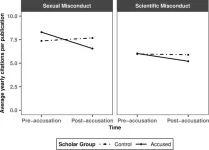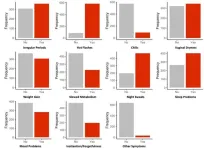(Press-News.org) For an abdominal wall hernia repair, also known as a ventral hernia repair, the most common surgical approaches have been laparoscopic and open techniques.
But a new approach for repairing hernias has been steadily growing in popularity: the surgical robot.
Supporters of using the robot method state multiple advantages over traditional laparoscopic and open approaches, including improved surgeon ergonomics.
But there may be downsides to the technology that are going undiscussed.
In a research article published in JAMA Surgery, Brian Fry, M.D., M.S., a general surgery resident at University of Michigan Health and colleagues compared hernia recurrence rates after undergoing robotic, laparoscopic and open repairs.
The study analyzed a large sample of Medicare-insured patients undergoing ventral hernia repairs and found that those undergoing repairs using a robotic approach had higher rates of their hernias recuring when compared to patients who underwent repair with a laparoscopic or open approach.
However, despite the higher recurrence rate for those undergoing robotic repairs, the rates were only 1.1% higher than laparoscopic repairs and 0.7% higher than open repairs at 10 years after surgery.
“Despite evidence for its benefit in certain surgical procedures such as prostate surgery, our data adds to the large body of work demonstrating no substantial clinical benefit when using the robot for ventral hernia repair on a large scale,” said Fry.
“We are undoubtedly capturing an element of the learning curve for robotics that was present when laparoscopy first hit the scene. We initially saw higher complication and hernia recurrence rates when laparoscopic hernia repairs were first introduced, but we still pushed to overcome the ‘learning curve’ of people picking up the procedure because it was a paradigm shift in hernia care.”
Robotic and laparoscopic hernia repairs use similarly small cuts in the skin, but the robot allows 3-dimensional vision and articulating wrist technology that makes it easier for a surgeon to see and sew.
But research has shown that robotic repairs take longer, and the technology of the robot costs much more than traditional laparoscopy.
Upon initial introduction of the robotic surgery for hernias, length of stay and postoperative recovery times were greatly reduced due to much smaller incisions, and the inferior initial outcomes as a surgeon worked through their learning curve were offset by clear benefits.
However, Fry states that it’s much harder to argue that robotics offers a similar paradigm-shifting advantage over laparoscopy that would justify potentially inferior outcomes.
Fry and his team of researchers believe the incremental benefit of the robot, particularly as it is currently being used nationwide within hernia repair, is worth questioning.
“More work needs to be done to understand which patients, hernias and specific operative techniques are best able to leverage the robot’s strengths and provide true clinical benefit to the patient,” said Fry.
“The robot may provide benefit for more advanced operative techniques used to repair very large or complex hernias, as these repairs are rarely attempted laparoscopically. However, most hernia repairs are performed by general surgeons out in the community, not by hernia specialists at large hospital systems.”
According to Fry, robotic surgical hernia repair is here to stay and it’s up to surgeons to figure out how we can best harness the technology to maximize its potential benefits.
“With the rapid uptake and popularity of robotic hernia repair, it is important that we figure out how to best train and credential surgeons on the platform as well as carefully select patients and techniques that leverage the true advantages of the technology.”
Additional authors: Ryan A. Howard, M.D., M.S. and Kyle H. Sheetz, M.D., M.S. from the Department of Surgery, University of Michigan, Ann Arbor and the Center for Health care Outcomes and Policy, University of Michigan, Ann Arbor; Jyothi R. Thumma, M.P.H from the Center for Healthcare Outcomes and Policy, University of Michigan, Ann Arbor; Edward C. Norton, Ph.D. from the Center for Healthcare Outcomes and Policy, University of Michigan, Ann Arbor, the Department of Health Management and Policy, University of Michigan, Ann Arbor, and the Department of Economics, University of Michigan, Ann Arbor; and Justin B. Dimick, M.D., M.P.H from the Department of Surgery, University of Michigan, Ann Arbor, the Center for Healthcare Outcomes and Policy, University of Michigan, Ann Arbor, and Surgical Innovation Editor, JAMA Surgery.
Conflict of Interest: Fry reported receiving salary support from the National Institutes of Health (grant T32-AG062403) during the conduct of the study and funding from the Society of American Gastrointestinal and Endoscopic Surgeons. Dimick reported receiving personal fees from ArborMetrix outside the submitted work and being an equity owner of ArborMetrix.
Funding/disclosures: This work was supported by grant R01-DK131584-01 from the National Institute of Diabetes and Digestive and Kidney Diseases to Drs Sheetz and Dimick.
Paper cited: “Surgical Approach and Long-Term Recurrence After Ventral Hernia Repair,” JAMA Surgery. DOI: 10.1001/jamasurg.2024.1696
END
Are robotic hernia repairs still in the “learning curve” phase?
2025-03-05
ELSE PRESS RELEASES FROM THIS DATE:
New STI impacts 1 in 3 women: Landmark study reveals men are the missing link
2025-03-05
A landmark study reveals that bacterial vaginosis (BV), a condition affecting nearly a third of women worldwide and causing infertility, premature births and newborn deaths, is in fact a sexually transmitted infection (STI), paving the way for a revolution in how it is treated.
Monash University and Alfred Health researchers at the Melbourne Sexual Health Centre say their findings, published today in the New England Journal of Medicine, hold the key to driving down stubborn and distressing recurrence ...
Feeling is believing: Bionic hand “knows” what it’s touching, grasps like a human
2025-03-05
Johns Hopkins University engineers have developed a pioneering prosthetic hand that can grip plush toys, water bottles, and other everyday objects like a human, carefully conforming and adjusting its grasp to avoid damaging or mishandling whatever it holds.
The system’s hybrid design is a first for robotic hands, which have typically been too rigid or too soft to replicate a human’s touch when handling objects of varying textures and materials. The innovation offers a promising solution for people with hand loss and could improve how robotic arms interact with their environment.
Details about the device appear today in Science Advances.
“The ...
Damon Runyon Cancer Research Foundation awards $4.4 million to top young scientists
2025-03-05
The Damon Runyon Cancer Research Foundation has named 13 new Damon Runyon Fellows, exceptional postdoctoral scientists conducting basic and translational cancer research in the laboratories of leading senior investigators. The prestigious, four-year Fellowship encourages the nation's most promising young scientists to pursue careers in cancer research by providing them with independent funding ($300,000 total) to investigate cancer causes, mechanisms, therapies, and prevention.
The Foundation has also named ...
Over-the-counter pain relievers linked to improved recovery from concussion
2025-03-05
EMBARGOED FOR RELEASE UNTIL 4 P.M. ET, WEDNESDAY, MARCH 5, 2025
Media Contacts:
Renee Tessman, rtessman@aan.com, (612) 928-6137
Natalie Conrad, nconrad@aan.com, (612) 928-6164
Over-the-counter pain relievers linked to improved recovery from concussion
MINNEAPOLIS – People who take over-the-counter pain relievers after a concussion may recover faster than those who do not take pain relievers, according to a preliminary study released today, March 5, 2025, that will be presented at the American Academy of Neurology’s 77th Annual Meeting taking place April 5–9, 2025, in San Diego ...
Stressed out? It may increase the risk of stroke
2025-03-05
MINNEAPOLIS — Some people living with chronic stress have a higher risk of stroke, according to a study published on March 5, 2025, online in Neurology®, the medical journal of the American Academy of Neurology. The study looked at younger adults and found an association between stress and stroke, with no known cause, in female participants, but not male participants. This study does not prove that stress causes stroke; it only shows an association.
“Younger people often experience stress due to the demands and pressures associated with work, including long hours and job insecurity, as well as financial burdens,” ...
Nanoscale tweaks help alloy withstand high-speed impacts
2025-03-05
ITHACA, N.Y. – A Cornell University-led collaboration devised a new method for designing metals and alloys that can withstand extreme impacts, which could lead to the development of automobiles, aircraft and armor that can better endure high-speed impacts, extreme heat and stress.
The research, published in Communications Materials, introduces nanometer-scale speed bumps that suppress a fundamental transition that controls how metallic materials deform.
The project was led by Mostafa Hassani, assistant professor of mechanical ...
AI-generated voices which sound like you are perceived as more trustworthy and likeable, with implications for deep-fakes and manipulation
2025-03-05
AI-generated voices which sound like you are perceived as more trustworthy and likeable, with implications for deep-fakes and manipulation
Article URL: https://plos.io/4baFCW5
Article title: AI-determined similarity increases likability and trustworthiness of human voices
Author countries: Germany
Funding: The author(s) received no specific funding for this work. END ...
The cacao tree species (Theobroma cacao L.), from which we get chocolate, is likely about 7.5 million years old, with chloroplast genomes indicating that the current known diversity diversified during
2025-03-05
The cacao tree species (Theobroma cacao L.), from which we get chocolate, is likely about 7.5 million years old, with chloroplast genomes indicating that the current known diversity diversified during the Pliocene or Miocene epochs
Article URL: https://plos.io/4gQHlB2
Article title: Comparative analyses of chloroplast genomes of Theobroma cacao from northern Peru
Author countries: Perú
Funding: This study was supported by the Programa Nacional de Investigación Científica y Estudios Avanzados (PROCIENCIA) funded by the Project through the Contract N° 026-2016-FONDECYT “Círculo de Investigación ...
After sexual misconduct accusations, scholars’ work is cited less
2025-03-05
In a new analysis, scholars publicly accused of sexual misconduct experienced a significant decrease in the rate at which other scholars cited their published research. Giulia Maimone of the University of California, Los Angeles, U.S., and colleagues present these findings in the open-access journal PLOS One on March 5, 2025.
In academia, scholars cite other scholars’ publications as a widely agreed-upon way to reference existing research and promote scientific advancement. A scholar with a high number of citations may be considered particularly impactful in their field. Prior research ...
Menopause symptoms associated with future memory and neuropsychiatric problems
2025-03-05
Women who exhibit more menopausal symptoms are more likely to later have poorer cognitive function and mild behavioral impairments – both markers of dementia. That is the conclusion of a study of 896 postmenopausal females published March 5, 2025, in the open-access journal PLOS One by Zahinoor Ismail of University of Calgary, Canada, and colleagues.
Females are known to have a three-fold greater risk of developing Alzheimer’s disease and related dementias, and will be disproportionately ...




